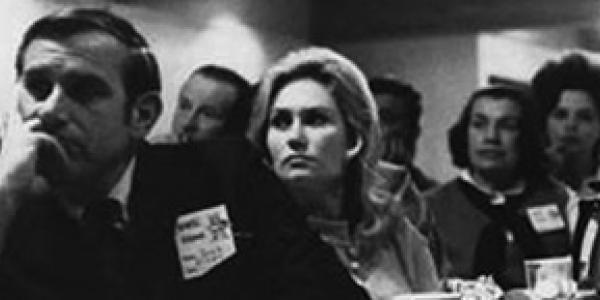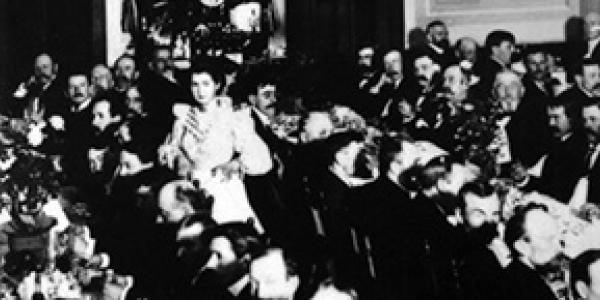Alumni History
Alumni History
In June 1900, the first graduates of the Washington State Normal School at Whatcom founded the first alumni association for WWU. The relationship between the alumni and the school took its first steps toward formalization in 1901, when graduating students performed a class play for alumni as a part of commencement exercises. The alumni program expanded in 1903 and 1904 to include a banquet for the graduating class, faculty, trustees, and alumni. The junior class began a tradition of recognizing the achievements of earlier students, creating a foundation of support for their own post-school years. Formal organization of the alumni association came in 1906. By 1908 the group had begun having an annual meeting. Tradition dictated that this be held on the Saturday preceding commencement, a practice that continued until 1950.
Professional education bonded Western’s first graduates together. The Normal School trained and re-certified teachers, issued licenses, and generally considered itself to have a lifelong responsibility for the continued growth of alumni. This network of support exists today, as alumni mentor undergraduates, support the programs and education of students, and hire graduates.
Alumni programming reflected this uniformity of purpose, as did the activities of the former WWU Alumni Association. Western alumni met one another in their daily work as teachers and were urged by their employers to maintain contact with their alma mater. The faculty of the Normal School (later College) took part in the in-service training of teachers and, at the same time, were able to maintain contact with alumni. The faculty could evaluate their own efforts, and also keep alumni aware of campus developments.
Much of the early leadership in the alumni relations at Western came from Professor Linus Kibbe, who, as part of his duties as yearbook advisor, would editorialize on the importance of the alumni outreach to the continued vigor of the school. Under his leadership, the first homecoming was held in 1924. A banquet, luncheon, and football game for the enjoyment of returning alumni became a part of the fall season. The spring banquet continued. The Alumni Association’s place was secure with the homogenous environment of Western Washington College of Education. Growing with the post-World War II demand for more teachers, the alumni office was an integral part of the public education network serving the state’s public schools. It served alumni needs and provided the social occasions that were beyond the province of the institution itself.
Arthur Hicks, (professor emeritus of English) writing in Western at 75 (WWSC, 1974) refers to 1959 as the “Great Divide.” The retirement of Dr. William Haggard, following 22 years of service, began a shift away from professional education’s dominance. A liberal arts institution was born, and with it expansion of Western.
President James Jarrett arrived in 1959 with a new charge, new goals, and a fresh perspective. The Jarrett years concluded in 1964, the same year the former WWU Alumni Association became a Washington State chartered non-profit corporation. The Association’s operations were funded by a small dues program which provided for the minimal expenses.
Dr. Harvey C. Bunke became president in 1965, and he began a period of redefinition and rejuvenation of alumni programming.
Prior to this time, alumni records were kept as a part of the Placement Office or Appointment Bureau, as it was known. The placement of teachers and the maintenance of credentials were tied with alumni records. But the expansion of the arts and sciences curriculum led to a business and government placement service, and a greater workload. The Alumni Office came into being with the hiring of the first Alumni Director, Steve Inge, in 1968.
Born as part of the Department of Development and Public Information Office, the Alumni Office had a secretary, a director, and two student employees. The entire office included four professional areas—alumni administration, public information, publications, and fund-raising.
Three professional staff members interacted to produce programs, handle media relations, and produce printed materials for alumni. A newsletter, RESUME, was published on a monthly basis. Records were stored in an IBM 360-40 batch records system. Alumni relations began to flourish.
With the creation of the combined Office of Development and Public Information, Western placed an increased emphasis on private fundraising. The Western Foundation was created in 1966 to serve as the college’s fundraising arm, along with alumni annual giving.
During the presidency of Paul Olscamp (1975-1982), the alumni association began to seek its own resources and became financially independent of the Western Foundation. There were two approaches:
- Realizing that alumni would be a market for certain goods and services that the Association could provide, (programs of retail sales, group travel, and other enticements), Alumni Enterprises began in 1978. The program attempted to provide a profitable retailing operation.
- The second method was a creation, in 1981, of a dues-paying subgroup within the Alumni Association, called the WWU Alumni Club. Born in the spirit of fun and adventure, as well as to provide financial support to the university, it produced a five-fold increase in available resources.
This period was also marked by:
- Increased political activity as board members went to Olympia as a group and spoke on Western’s behalf to legislators;
- Expanded financial base with the establishment of a trust fund to insure scholarships in the future;
- Increased visibility of the Alumni Association on and off campus as members took an active part in directing the destiny of the Association.
In 1981, state revenues took a decided nose-dive, and, in effect, wiped out all but one person in each of the offices of Alumni Affairs, Public Information and Development.
In January of 1986, Steve Inge, the only Alumni Director the institution had ever had, moved to the position of Publications Director. At the same time, the Director of Public Information and Media Relations, Chris Goldsmith ('75) moved over to assume the Alumni Relations post. Goldsmith served for just over 17 years until his retirement.



With a firm anchor provided by his predecessors, the new director launched a program which would greatly increase revenues of the association over the next few years. Membership in the Alumni Club continued on a marked increase, while both overall Association assets and the annual budget experienced a period of rapid growth.
The tragic plane crash of 1987 which took the life of University President G. Robert Ross and two other university vice-presidents had the potential of undoing all of the advances of the previous four years. This was not to be the case, however. Acting President Albert Froderberg, who took over during the year following the plane crash, quickly moved to stabilize the institution and became quite active in supporting the alumni association’s continuing efforts to reach out to its constituency.
The arrival of President Kenneth P. Mortimer, who had a firm grounding in alumni and development from more than 19 years at Penn State, brought both an expanded state budget, and increased staffing level, in the Alumni Relations Office.
Past President Karen W. Morse continued the strong external affairs model at Western with her efforts to attend nearly every formally organized alumni event on the schedule; numbering 30-40/yr, both in the Puget Sound area and elsewhere throughout the country and the world. President Morse also launched and completed Western’s first-ever capital campaign.
In 2023, the WWU Foundation and the WWU Alumni Association combined into one, streamlined organization: The Foundation for WWU & Alumni.
Today, with Sabah Randhawa as President of Western Washington University, and Kim O'Neill heading The Foundation for WWU & Alumni, graduates of WWU are stepping into the next millennium.